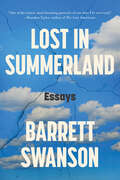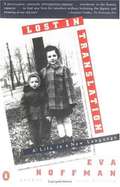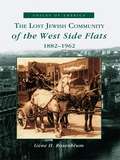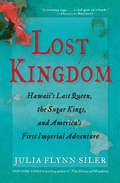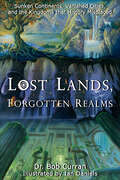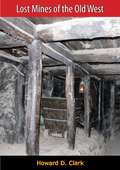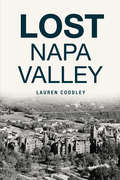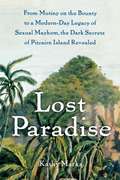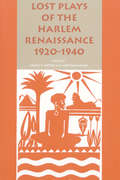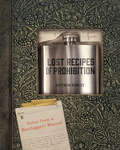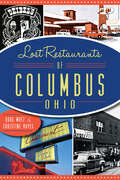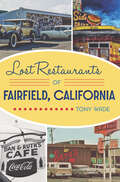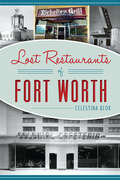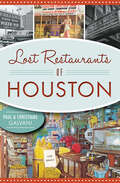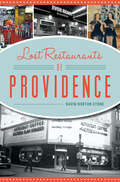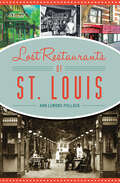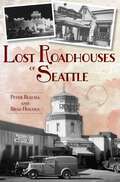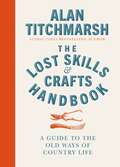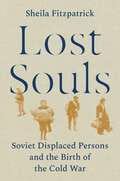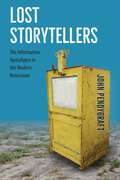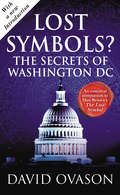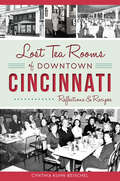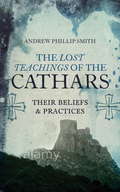- Table View
- List View
Lost History: The Enduring Legacy of Muslim Scientists, Thinkers, and Artists
by Michael Hamilton MorganIn an era when the relationship between Islam and the West seems mainly defined by mistrust and misunderstanding, it is important to remember that for centuries Muslim civilization was the envy of the world. Lost History fills a significant void and is essential reading for anyone seeking to understand the major the early Muslims played in influencing modern society. Morgan reveals how early Muslim advancements in science and culture laid the cornerstones of the European Renaissance, the Enlightenment, and modern Western society. As he chronicles the Golden Ages of Islam, beginning in A.D. 570 with the birth of Muhammad, and resonating today, he introduces scholars like Ibn Al-Haytham, Ibn Sina, Al-Tusi, Al-Khwarizmi, and Omar Khayyam, towering figures who revolutionized the mathematics, astronomy, and medicine of their time and paved the way for Newton, Copernicus, and many others. And he reminds us that inspired leaders from Muhammad to Suleiman the Magnificent and beyond championed religious tolerance, encouraged intellectual inquiry, and sponsored artistic, architectural, and literary works that still dazzle us with their brilliance. Lost History finally affords pioneering leaders with the proper credit and respect they so richly deserve.
Lost In Summerland: Essays
by Barrett SwansonBarrett Swanson embarks on a personal quest across the United States to uncover what it means to be an American amid the swirl of our post-truth climate in this collection of critically acclaimed essays and reportage. <P><P>A trip with his brother to a New York psychic community becomes a rollicking tour through the world of American spiritualism. <P><P>At a wilderness retreat in Ohio, men seek a cure for toxic masculinity, while in the hinterlands of Wisconsin, antiwar veterans turn to farming when they cannot sustain the heroic myth of service. And when his best friend’s body washes up on the shores of the Mississippi River, he falls into the gullet of true crime discussion boards, exploring the stamina of conspiracy theories along the cankered byways of the Midwest. <P><P>In this exhilarating debut, Barrett Swanson introduces us to a new reality. At a moment when grand unifying narratives have splintered into competing storylines, these critically acclaimed essays document the many routes by which people are struggling to find stability in the aftermath of our country’s political and economic collapse, sometimes at dire and disillusioning costs.
Lost In Translation: A Life In A New Language
by Eva HoffmanWhen her parents brought her from the war-ravaged, faded elegance of her native Cracow in 1959 to settle in well-manicured, suburban Vancouver, Eva Hoffman was thirteen years old. Entering into adolescence, she endured the painful pull of nostalgia and struggled to express herself in a strange unyielding new language. <P><P> Her spiritual and intellectual odyssey continued in college and led her ultimately to New York’s literary world yet still she felt caught between two languages, two cultures. But her perspective also made her a keen observer of an America in the flux of change. <P> A classically American chronicle of upward mobility and assimilation. Lost in Translation is also an incisive meditation on coming to terms with one’s own uniqueness, on learning how deeply culture affects the mind and body, and finally, on what it means to accomplish a translation of one’s self.
Lost Jewish Community of the West Side Flats 1882-1962, The: 1882-1962 (Voices of America)
by Gene H. RosenblumBeginning in 1882, many Russian and Eastern-European Jews who fled to the United States settled in the "West Side Flats" in St. Paul, Minnesota. The area once stretched from the banks of the Mississippi River to the cliffs of the West Side Hills, about 320 acres in all, but has since fallen victim to the vagaries of the mighty river and the progress of "urban renewal." The Lost Jewish Community of the West Side Flats: 1882-1962 takes the reader on a pictorial tour down memory lane. The families, houses, businesses, streets, and synagogues-all vanished now-are brought back to life through vintage photographs from the archives of the Jewish Historical Society of the Upper Midwest, the Minnesota Historical Society, and the private collections of many former residents. This is a memoir of a historic neighborhood that can no longer be visited.
Lost Kingdom: Hawaii's Last Queen, the Sugar Kings, and America's First Imperial Adventure
by Julia Flynn SilerThe New York Times–bestselling author delivers “a riveting saga about Big Sugar flexing its imperialist muscle in Hawaii . . . A real gem of a book” (Douglas Brinkley, author of American Moonshot). Deftly weaving together a memorable cast of characters, Lost Kingdom brings to life the clash between a vulnerable Polynesian people and relentlessly expanding capitalist powers. Portraits of royalty and rogues, sugar barons, and missionaries combine into a sweeping tale of the Hawaiian Kingdom’s rise and fall. At the center of the story is Lili‘uokalani, the last queen of Hawai‘i. Born in 1838, she lived through the nearly complete economic transformation of the islands. Lucrative sugar plantations gradually subsumed the majority of the land, owned almost exclusively by white planters, dubbed the “Sugar Kings.” Hawai‘i became a prize in the contest between America, Britain, and France, each seeking to expand their military and commercial influence in the Pacific. The monarchy had become a figurehead, victim to manipulation from the wealthy sugar plantation owners. Lili‘u was determined to enact a constitution to reinstate the monarchy’s power but was outmaneuvered by the United States. The annexation of Hawai‘i had begun, ushering in a new century of American imperialism. “An important chapter in our national history, one that most Americans don’t know but should.” —The New York Times Book Review “Siler gives us a riveting and intimate look at the rise and tragic fall of Hawaii’s royal family . . . A reminder that Hawaii remains one of the most breathtaking places in the world. Even if the kingdom is lost.” —Fortune “[A] well-researched, nicely contextualized history . . . [Indeed] ‘one of the most audacious land grabs of the Gilded Age.’” —Los Angeles Times
Lost Lands, Forgotten Realms: Sunken Continents, Vanished Cities, and the Kingdoms that History Misplaced
by Bob Curran“A comprehensive encyclopedia of fantastic places straddling the nebulous borderlands between fact and fantasy.” —Frank Joseph, author of Opening the Ark of the CovenantThere are places that turn up in literature or in film—mystical and legendary places whose names may be familiar but about which we know little. We nod knowingly at the reference, but are often left wondering about places such as Atlantis, the lost land overwhelmed by the sea, or El Dorado, the fabulous city that vanished somewhere in the South American jungles. Other names are more evocative—Mount Olympus, the Garden of Eden, the mystic Isle of Avalon, and Davy Jones’ Locker.But did such places actually exist and if so, where were they, and what really happened? What are the traditions and legends associated with them? In the fascinating book, Lost Lands, Forgotten Realms, historian Dr. Bob Curran sets out to find the answers by journeying to the far-flung corners of the world and to the outer reaches of human imagination.“In this fascinating encyclopedia of places that time forgot, Irish psychologist and historian Dr. Bob Curran brings the legends alive.” —Nexus magazine“Learned and erudite, yet written in an accessible and exceptionally readable style, this book is invaluable for those interested in the mysteries of vanished civilizations.” —Brian Haughton, author of Hidden History
Lost Mines of the Old West
by Howard D. Clark Ray HetheringtonAUTHENTIC STORY OF THE “PEGLEG” AND 21 OTHER STORIES OF FABULOUS LOST MINES!Author Howard D. Clark, a Kansas native, had an extensive career in journalism with appointments including managing editor for the Farm Press Publications of Chicago, Illinois; staff writer for a number of business papers; and statistical and analytical specialist for other periodicals and concerns.This background, plus extensive travel on the Pacific Coast, fitted him particularly well to undertake the writing of this book. Lost mine legends make up a large section of Western folklore. In this collection he has made a sincere effort to present only the most important and best authenticated of them all. He has also had the invaluable assistance of Ray Hetherington, an unquestioned authority in the field of Western Americana. Much of the source material used herein was collected by Mr. Hetherington through thirty years of extensive research.First published in 1946, this collection of lost mine legends is considered among the most complete and factual of any ever assembled.
Lost Napa Valley (Lost)
by Lauren CoodleyNapa Valley, once known for its cattle and silver mines, has grown into an international wine destination. On the way, many buildings and institutions have vanished. From the Von Uhlit family's fruit farm in Napa to the Wheeler Ranch in St. Helena, fields and orchards became neighborhoods and vineyards. The Dolphin, a steamboat that once delivered travelers from San Francisco, was replaced by faster transport, and the Napa State Hospital's original "castle" was demolished. The Sawyer Tannery, in operation for over one hundred years, closed its doors in 1990, and destinations like the Kay Von Drive-In and the Bel Aire Bowl now live on only in memory. Join author and historian Lauren Coodley as she celebrates these once-beloved landmarks in California's Wine Country.
Lost Paradise: From Mutiny on the Bounty to a Modern-day Legacy of Sexual Mayhem, the Dark Secrets of Pitcairn Island Revealed
by Kathy MarksPitcairn Island -- remote and wild in the South Pacific, a place of towering cliffs and lashing surf -- is home to descendants of Fletcher Christian and the Mutiny on the Bounty crew, who fled there with a group of Tahitian maidens after deposing their captain, William Bligh, and seizing his ship in 1789. Shrouded in myth, the island was idealized by outsiders, who considered it a tropical Shangri-La. But as the world was to discover two centuries after the mutiny, it was also a place of sinister secrets. In this riveting account, Kathy Marks tells the disturbing saga and asks profound questions about human behavior. In 2000, police descended on the British territory -- a lump of volcanic rock hundreds of miles from the nearest inhabited land -- to investigate an allegation of rape of a fifteen-year-old girl. They found themselves speaking to dozens of women and uncovering a trail of child abuse dating back at least three generations. Scarcely a Pitcairn man was untainted by the allegations, it seemed, and barely a girl growing up on the island, home to just forty-seven people, had escaped. Yet most islanders, including the victims' mothers, feigned ignorance or claimed it was South Pacific "culture" -- the Pitcairn "way of life." The ensuing trials would tear the close-knit, interrelated community apart, for every family contained an offender or a victim -- often both. The very future of the island, dependent on its men and their prowess in the longboats, appeared at risk. The islanders were resentful toward British authorities, whom they regarded as colonialists, and the newly arrived newspeople, who asked nettlesome questions and whose daily dispatches were closely scrutinized on the Internet. The court case commanded worldwide attention. And as a succession of men passed through Pitcairn's makeshift courtroom, disturbing questions surfaced. How had the abuse remained hidden so long? Was it inevitable in such a place? Was Pitcairn a real-life Lord of the Flies? One of only six journalists to cover the trials, Marks lived on Pitcairn for six weeks, with the accused men as her neighbors. She depicts, vividly, the attractions and everyday difficulties of living on a remote tropical island. Moreover, outside court, she had daily encounters with the islanders, not all of them civil, and observed firsthand how the tiny, claustrophobic community ticked: the gossip, the feuding, the claustrophobic intimacy -- and the power dynamics that had allowed the abuse to flourish. Marks followed the legal and human saga through to its recent conclusion. She uncovers a society gone badly astray, leaving lives shattered and codes broken: a paradise truly lost.
Lost Plays of the Harlem Renaissance, 1920-1940
by James V. Hatch Leo HamalianA valuable contribution to African American literary and theatrical scholarship, this volume is a compilation of sixteen plays written during the Harlem Renaissance, brought together for the first time and set in a historical context.
Lost Recipes of Prohibition: Rediscovered Formulas And Forgotten Recipes For Liquors, Cordials, And Wines From The Secret Notebook Of A Prohibition-era Doctor
by Matthew RowleyNearly everyone has heard of bathtub gin, but how many people know what it really was--or how to make it? During the height of the Prohibition, one anonymous physician compiled more than 200 recipes for "compounding" spirits, hiding the manuscript from authorities. By adding extracts, essences, and oils to plain old sugar moonshine, bootleggers would simulate the taste of gin, whiskey, cordials, rums, absinthes. . . booze that was otherwise impossible to procure. The potential profits were staggering. This document fell into the hands of author Matthew Rowley, who became fascinated with the process of compounding and the historical events that lead to this mysterious and lucrative manuscript. In addition to annotating the actual pages of the book, Rowley provides a historical background, and gives his readers an overview of the process, updating some of the recipes for modern distillers, bartenders, and cocktail enthusiasts.
Lost Restaurants of Columbis, Ohio (Lost Ser.)
by Christine Hayes Doug MotzDig into the storied restaurant history of the Buckeye State&’s capital city. Ohio&’s capital city has long had a vibrant restaurant culture that included German immigrants, High Street eateries and the fads of the times. Gertrude Stein and Alice B. Toklas wrote their thanks for a great meal at the Maramor. Yankees star Tommy Henrich held his customers spellbound with stories in his Diamond Room. Mama Marzetti dropped William Oxley Thompson&’s birthday cake and swept it back up off the floor. Join authors Doug Motz and Christine Hayes as they explore the stories of Woody Hayes&’s Jai Lai, manhole cover menus and bathtub décor at Water Works, as well as many other lost and beloved restaurants.
Lost Restaurants of Fairfield, California (American Palate)
by Tony WadeDelve into the memories, meals, and the men and women behind Fairfield's' beloved former dining spots.Since the city's incorporation in 1903, Fairfield's restaurants have reflected the simple tastes of suburban life, serving up good food and great times at places like the Firehouse Deli-Café, the Hi-Fi Drive-In and beyond. Longtime residents knew the best Mexican food north of Tijuana could be found at Dan & Ruth's Café, and Voici, where the movers and shakers met, claimed the crown as swankiest spot in town. Smorga Bob's, the buffet-style family restaurant where locals could let their hair down and get their grub on, is missed to this day.Join longtime Daily Republic columnist and accidental local historian Tony Wade on a delicious tour of bygone eateries.
Lost Restaurants of Forth Worth (American Palate)
by Celestina BlokDespite a thriving culinary scene, Fort Worth lost some of its most iconic restaurants decades ago. Locals still buzz about the legendary chili dished out at historic Richelieu Grill and the potato soup Sammy's served all night. Fort Worth could accommodate every palate, from the Bakon Burger at Carlson's Drive-Inn to the escargot and chateaubriand laid out at the Carriage House. Even movie stars like Bob Hope and Gene Autry frequented the city for steaks from the Seibold Café, and President Lyndon B. Johnson loved Cowtown for the barbecue from famed chuckwagon cook Walter Jetton. Join food writer Celestina Blok as she journeys through her hometown's dining past.
Lost Restaurants of Houston (American Palate)
by Paul Galvani Christiane Galvani&“Stories of immigration, culture-clash . . . and old-fashioned hard work are told through the history of Houston&’s long-gone, but still-beloved restaurants.&” —Yesterday&’s America With more than fourteen thousand eating establishments covering seventy different ethnic cuisines, Houston is a foodie town. But even in a place where eating out is a way of life and restaurants come and go, there were some iconic spots that earned a special place in the hearts and stomachs of locals. Maxim&’s taught overnight millionaires how to handle meals that came with three forks. The Trader Vic&’s at the Shamrock offered dedicated homebodies a chance for the exotic, and Sonny Look&’s Sirloin Inn maintained the reputation of a city of steakhouses. From Alfred&’s Delicatessen to Youngblood&’s Fried Chicken, Paul and Christiane Galvani celebrate the stories and recipes of Houston&’s fondly remembered tastemakers. &“In the book, the Galvanis share Houston&’s history and love of food. They take the reader on the banks of the bayou when the city received its first inhabitants before time hopping from the Original Mexican Restaurant to The Original Kelley&’s Steakhouse. Other stops include Alfred&’s Delicatessen and the San Jacinto Inn.&” —Houston Business Journal
Lost Restaurants of Providence (American Palate)
by David Norton StoneA culinary history of Providence and the memorable eateries that once made their homes there. In the city that invented the diner, so many amazing restaurants remain only in memories. The Silver Top had fresh coffee every twenty minutes, and the Ever Ready was hot dog heaven. Miss Dutton's Green Room and the Shepard Tea Room beckoned shoppers in their Sunday finest. At Childs, the griddle chef made butter cakes in the window for night owls, and Harry Houdini supped at midnight with H.P. Lovecraft at the Waldorf Lunch. Themed lounges like the Beachcomber and the Bacchante Room chased away the Prohibition blues. Downcity Diner offered a famous meatloaf, and Ming Garden&’s Ming Wings were a staple for regulars. Author David Norton Stone details the restaurants that still hold a place in the hearts of locals
Lost Restaurants of St. Louis (American Palate Ser.)
by Ann Lemons PollackA culinary history of the Gateway City and the memorable restaurants that once made their home there.St. Louis is a food town, and there are many restaurants that have captured the heart of the city. Some of them are no longer around. Rossino&’s low ceilings and even lower pipes didn&’t stop the pizza-hungry residents from crowding in. Jefferson Avenue Boarding House served elegant &“Granny Food&” in plush surroundings. King Burgers and onion rings ruled at the Parkmoor. Dohack&’s claimed it was the first to name the &“jack salmon.&” Author Ann Lemons Pollack details these and more restaurants lost to time in the Gateway City.&“Few St. Louisans know the history of the St. Louis food scene like local food and travel writer Ann Lemons Pollack. . . . The book is a treasure trove for St. Louis history-lovers, beginning with an extensively researched look at the food served at the 1904 Louisiana Purchase Exposition—better known as the 1904 World&’s Fair—hosted in St. Louis. She debunks some myths—hot dogs were not &“invented&” at the fair, but perhaps found a wide audience there—and charts the various restaurants and cafes that fed eager fairgoers.&”—Feast Magazine
Lost Roadhouses of Seattle (American Palate)
by Brad Holden Peter BlechaProhibition came early to Washington State--in 1916--and kicked off an unforgettable era of nightlife.Prohibition went national in 1920 and a network of roadside inns, taverns and dancehalls just outside of Seattle's city limits thrived well into the rockin' 1950s, providing illicit entertainment for those seeking a good time. Spurred on by early car culture and strict liquor laws, places like the Spanish Castle, The Jungle and The Black Cat sprang into being. Commonly called roadhouses, many of these remote outposts existed along two newly-built and parallel stretches of county highways - far from the prying eyes of city police. Fabled speakeasy operator, "Doc" Hamilton founded some of the earliest of these hideaways.Join authors Peter Blecha and Brad Holden as they uncover the fascinating era of forbidden nightclubs.
Lost Skills and Crafts Handbook
by Alan TitchmarshIn this inspirational and practical guide to country life, passionate and hugely knowledgeable countryman Alan Titchmarsh explores the heritage of rural Britain, its landscapes and wildlife, its traditions, customs and crafts. The Lost Skills and Crafts Handbook will help you rediscover your love of the countryside, including:- a checklist of British butterflies and where to find them- how to keep chickens, ducks, goats and sheep- how to make soap, candles and your own herbal remedies- how to track animals and forage for food- essential knot tying- how to build a campfire without matches- how to create a kitchen garden- the origins of country superstitionsAnd much more. With beautiful line art illustrations throughout, this compendium of the British countryside and its delights will be an essential read for any nature lover in your life.
Lost Souls: Manners and Morals in Contemporary American Society
by James D. WrightWhat is the state of contemporary American morality? From their original conception in Christian scripture to their assimilation into Western culture, the 'Seven Deadly Sins' – lust, greed, envy, pride, and all the rest – have guided human morality, steering human behavior and psychology away from evil and toward a full embrace of the good. But their hold on modern life is increasingly tenuous. Indeed, one may observe that these days, deadly sin is far more common and more commonly practiced than its virtuous counterparts – humility, charity, kindness, industriousness, and chastity. Without greed, there is no economy; without anger, no politics; and without pride and envy, surely less motivation and competition would exist. James D. Wright carefully examines the complexities and ambiguities in modern society in the context of the seven deadly sins and their corresponding virtues. Are we all lost souls, condemned by our immoral deeds, or are the trappings of older sin deteriorating? Is it time, finally, to reconsider the classifications of evil and good? Wright uses each chapter to consider how the social sciences have operationalized each 'sin', how they have been studied, and what lessons have been learned over time. He reviews recent trends and contemplates the societal costs and benefits of the behaviors in question. Lost Souls emerges, then, as a meditation on contemporary sin, concluding that the line between guilt and innocence, right and wrong, is often very thin.
Lost Souls: Soviet Displaced Persons and the Birth of the Cold War
by Sheila FitzpatrickA vivid history of how Cold War politics helped solve one of the twentieth century&’s biggest refugee crisesWhen World War II ended, about one million people whom the Soviet Union claimed as its citizens were outside the borders of the USSR, mostly in the Western-occupied zones of Germany and Austria. These &“displaced persons,&” or DPs—Russians, prewar Soviet citizens, and people from West Ukraine and the Baltic states forcibly incorporated into the Soviet Union in 1939—refused to repatriate to the Soviet Union despite its demands. Thus began one of the first big conflicts of the Cold War. In Lost Souls, Sheila Fitzpatrick draws on new archival research, including Soviet interviews with hundreds of DPs, to offer a vivid account of this crisis, from the competitive maneuverings of politicians and diplomats to the everyday lives of DPs.American enthusiasm for funding the refugee organizations taking care of DPs quickly waned after the war. It was only after DPs were redefined—from &“victims of war and Nazism&” to &“victims of Communism&”—in 1947 that a solution was found: the United States would pay for the mass resettlement of DPs in America, Australia, and other countries outside Europe. The Soviet Union protested this &“theft&” of its citizens. But it was a coup for the United States. The choice of DPs to live a free life in the West, and the West&’s welcome of them, became an important theme in America&’s Cold War propaganda battle with the Soviet Union.A compelling story of the early Cold War, Lost Souls is also a rare chronicle of a refugee crisis that was solved.
Lost Storytellers: The Information Apocalypse in the Modern Newsroom
by John PendygraftCommunity journalism in the era of clickbait An incisive and firsthand look at the landscape of community news today, Lost Storytellers argues that the decline of local journalism threatens the future of democracy. Award-winning photojournalist John Pendygraft asks: How did Americans lose trust in the media, and how can their local newsrooms earn it back? Pendygraft uses his own experiences at Florida’s largest newspaper, the Tampa Bay Times, to illustrate why trusted local reporting matters more than ever in the era of “fake news,” clickbait, conspiracy theories, and social media. Through interviews with his colleagues, the history of his own paper, journeys into the evolutionary psychology of storytelling, and examples of the ways multinational media conglomerates hook readers on news cycles of chaos and crisis, Pendygraft argues that community journalists can reclaim their roles as local storytellers—and that the public good demands that they try. Lost Storytellers offers insights for all who feel confused about the media, politics, and the well-being of their communities in the information age.
Lost Symbols?: The Secrets of Washington DC
by David OvasonThe secrets, the myths and the facts behind Washington, D.C.'s design and its Masonic significance.In this groundbreaking, original work, David Ovason reveals the intimate connections between the mysterious zodiacal symbols and the stellar lore of Washington, D.C. and the secret plan for the city.There are over fifty complete zodiacs in Washington, D.C., all witness to an extraordinary stellar mystery. Why did generations of architects and artists put their lives and energies on the line, when designing this City of the Stars? What was their shared secret language? What or who drove them to create a city overflowing with such esoteric symbolism? What is the meaning behind the secret symbolism of Washington, D.C.'s layout? And what does it mean for America's future?
Lost Tea Rooms of Downtown Cincinnati: Reflections & Recipes (American Palate)
by Cynthia Kuhn BeischelIt was a different time. Ladies wore gloves, hats and nice attire to luncheons at the Woman's Exchange. Shillito's provided a cosmopolitan environment for its patrons, while Mullane's was the perfect place to sip and socialize. The popular Good Morning Show radio program hosted by charming Bob Braun, and later Nick Clooney, was broadcast from McAlpin's Tea Room. Women gathered at Pogue's and Mabley & Carew tea rooms to celebrate birthdays, as well as wedding and baby showers, over dainty tea sandwiches. Author Cynthia Kuhn Beischel brings the Queen City's bygone downtown tea rooms back to life and shares more than one hundred beloved recipes.
Lost Teachings of the Cathars
by Andrew Phillip SmithCenturies after the brutal slaughter of the Cathars by papally endorsed Northern French forces,and their suppression by the Inquisiton the medieval Cathars continue to exert a powerful influence on both popular culture and spiritual seekers. Yet few people know anything of the beliefs of the Cathars beyond vague notions that they believed in reincarnation, were vegetarians, were somehow Gnostic, and had some relation to Mary Magdalene. The Lost Teachings of the Cathars explores the history of this Christian dualist movement between the 12th and 14th centuries, offering a sympathetic yet critical examination of its beliefs and practices. As well as investigating the origin of the Cathars, their relationship to the ancient Gnostics of the early centuries AD and the possibility that they survived the Inquisition in some way, the author also addresses recent renewed interest in Catharism. Eccentric esotericists initiated a neo-Cathar revival in the Languedoc which inspired the philosopher Simone Weil. The German Otto Rahn, who has been called the real-life Indiana Jones, believed that the Cathars were protectors of the Holy Grail and received support from Heinrich Himmler. Arthur Guirdham, a psychiatrist from the West of England, became convinced that he and a circle of patients had all been Cathars in previous lives. Tourists flock to the Languedoc to visit Cathar country. Bestsellers such as Kate Mosse's timeslip novel Labyrinth continue to fascinate readers. But what did the Cathars really believe and practice? From the Trade Paperback edition.

